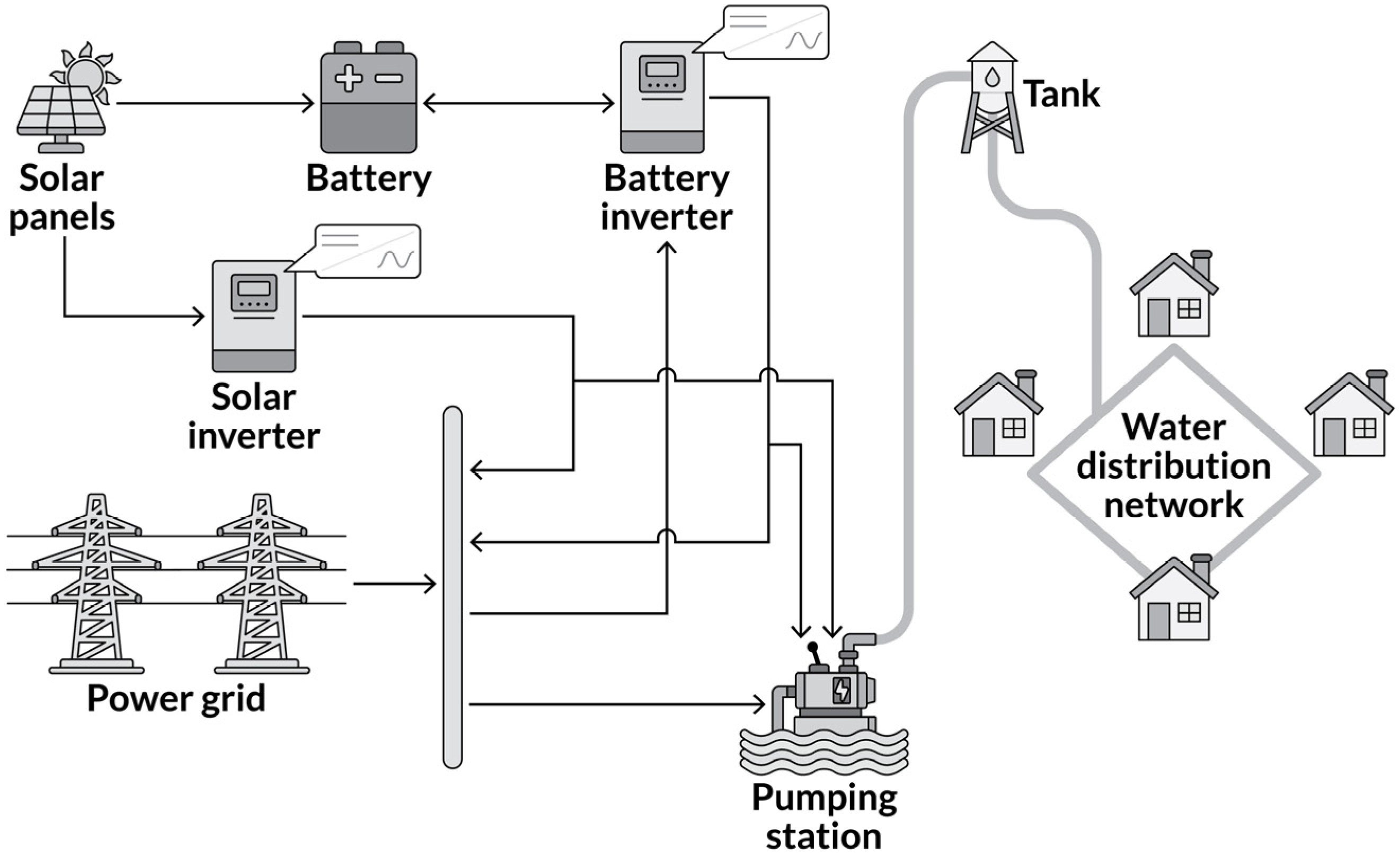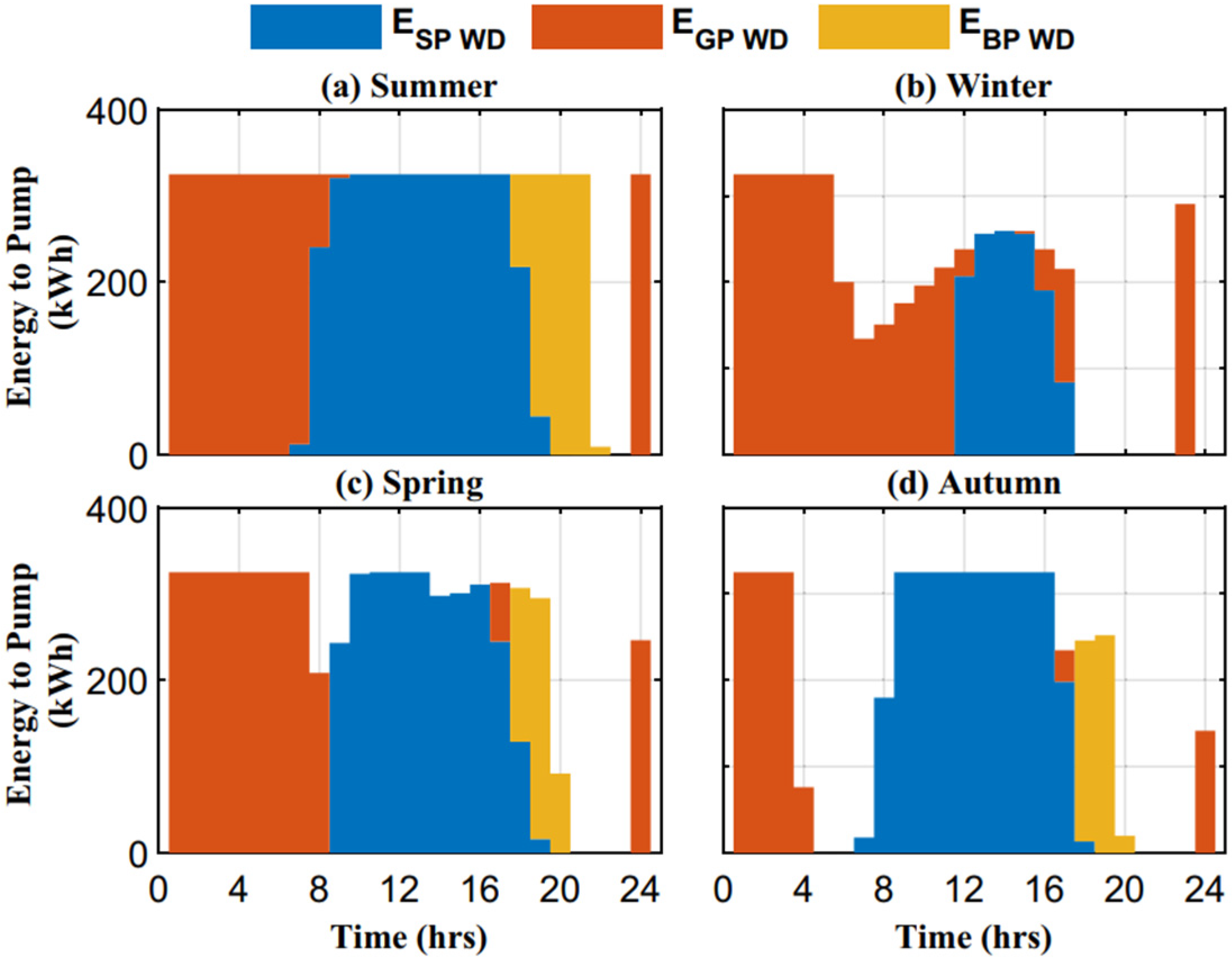Optimized Integration of Solar and Battery Systems in Water Distribution Networks †
Abstract
1. Introduction
2. Methodology
3. Results
4. Discussion and Conclusions
Author Contributions
Funding
Institutional Review Board Statement
Informed Consent Statement
Data Availability Statement
Acknowledgments
Conflicts of Interest
References
- Oikonomou, K.; Parvania, M.; Burian, S. Integrating Water Distribution Energy Flexibility in Power Systems Operation. In Proceedings of the IEEE Power and Energy Society General Meeting, Chicago, IL, USA, 16–20 July 2017; IEEE Computer Society: Washington, DC, USA, 2018; Volume 2018, pp. 1–5. [Google Scholar]
- Mala-Jetmarova, H.; Sultanova, N.; Savic, D. Lost in Optimisation of Water Distribution Systems? A Literature Review of System Operation. Environ. Model. Softw. 2017, 93, 209–254. [Google Scholar] [CrossRef]
- Giudicianni, C.; Mitrovic, D.; Wu, W.; Ferrarese, G.; Pugliese, F.; Fernández-García, I.; Campisano, A.; De Paola, F.; Malavasi, S.; Maier, H.R.; et al. Energy Recovery Strategies in Water Distribution Networks: Literature Review and Future Directions in the Net-Zero Transition. Urban Water J. 2023, 1–16. [Google Scholar] [CrossRef]
- Dall’Anese, E.; Mancarella, P.; Monti, A. Unlocking Flexibility: Integrated Optimization and Control of Multienergy Systems. IEEE Power Energy Mag. 2017, 15, 43–52. [Google Scholar] [CrossRef]
- Ayyagari, K.S.; Wang, S.; Gatsis, N.; Taha, A.F.; Giacomoni, M. Co-Optimization of Interdependent Water and Power Distribution Networks. In Proceedings of the 2021 IEEE Power & Energy Society Innovative Smart Grid Technologies Conference (ISGT), Washington, DC, USA, 16–18 February 2021. [Google Scholar] [CrossRef]
- Bhatraj, A.; Salomons, E.; Housh, M. An Optimization Model for Simultaneous Design and Operation of Renewable Energy Microgrids Integrated with Water Supply Systems. Appl. Energy 2024, 361, 122879. [Google Scholar] [CrossRef]
- Marchionni, V.; Cabral, M.; Amado, C.; Covas, D. Estimating Water Supply Infrastructure Cost Using Regression Techniques. J. Water Resour. Plan. Manag. 2016, 142, 04016003. [Google Scholar] [CrossRef]
- Choi, Y.; Kim, H. Optimal Scheduling of Energy Storage System for Self-Sustainable Base Station Operation Considering Battery Wear-Out Cost. Energies 2016, 9, 462. [Google Scholar] [CrossRef]
- Ramabhotla, S.; Bayne, S.B. Cost and Availability Optimization of Wind Energy with Distributed Energy Resources of a Microgrid. Wind Eng. 2019, 43, 559–572. [Google Scholar] [CrossRef]
- Magalim Solar Systems Cost. Available online: https://magalim.co.il/ (accessed on 9 April 2024).


Disclaimer/Publisher’s Note: The statements, opinions and data contained in all publications are solely those of the individual author(s) and contributor(s) and not of MDPI and/or the editor(s). MDPI and/or the editor(s) disclaim responsibility for any injury to people or property resulting from any ideas, methods, instructions or products referred to in the content. |
© 2024 by the authors. Licensee MDPI, Basel, Switzerland. This article is an open access article distributed under the terms and conditions of the Creative Commons Attribution (CC BY) license (https://creativecommons.org/licenses/by/4.0/).
Share and Cite
Bhatraj, A.; Salomons, E.; Housh, M. Optimized Integration of Solar and Battery Systems in Water Distribution Networks. Eng. Proc. 2024, 69, 151. https://doi.org/10.3390/engproc2024069151
Bhatraj A, Salomons E, Housh M. Optimized Integration of Solar and Battery Systems in Water Distribution Networks. Engineering Proceedings. 2024; 69(1):151. https://doi.org/10.3390/engproc2024069151
Chicago/Turabian StyleBhatraj, Anudeep, Elad Salomons, and Mashor Housh. 2024. "Optimized Integration of Solar and Battery Systems in Water Distribution Networks" Engineering Proceedings 69, no. 1: 151. https://doi.org/10.3390/engproc2024069151
APA StyleBhatraj, A., Salomons, E., & Housh, M. (2024). Optimized Integration of Solar and Battery Systems in Water Distribution Networks. Engineering Proceedings, 69(1), 151. https://doi.org/10.3390/engproc2024069151







